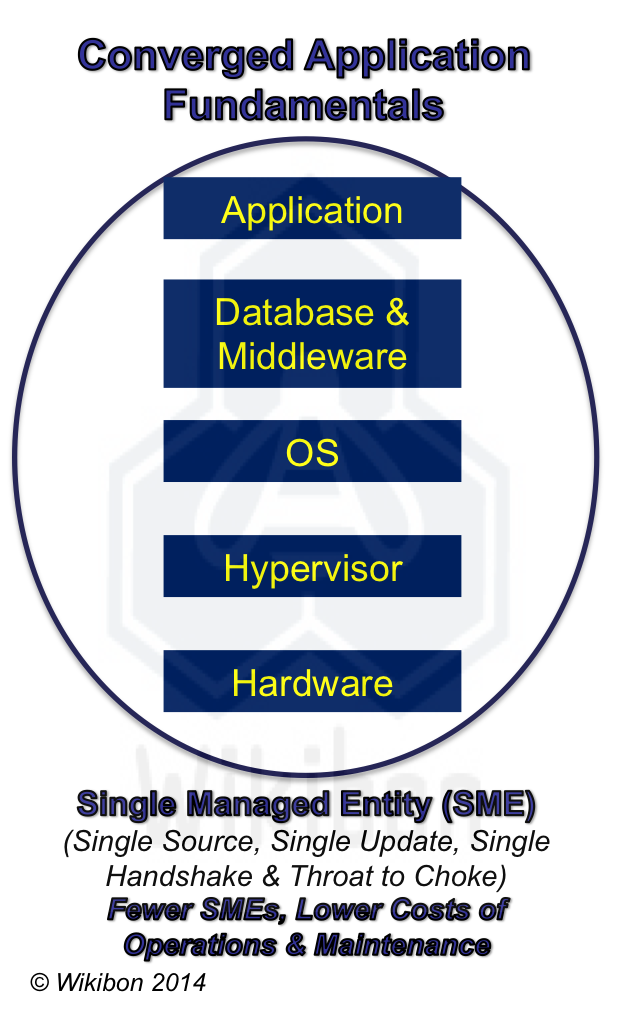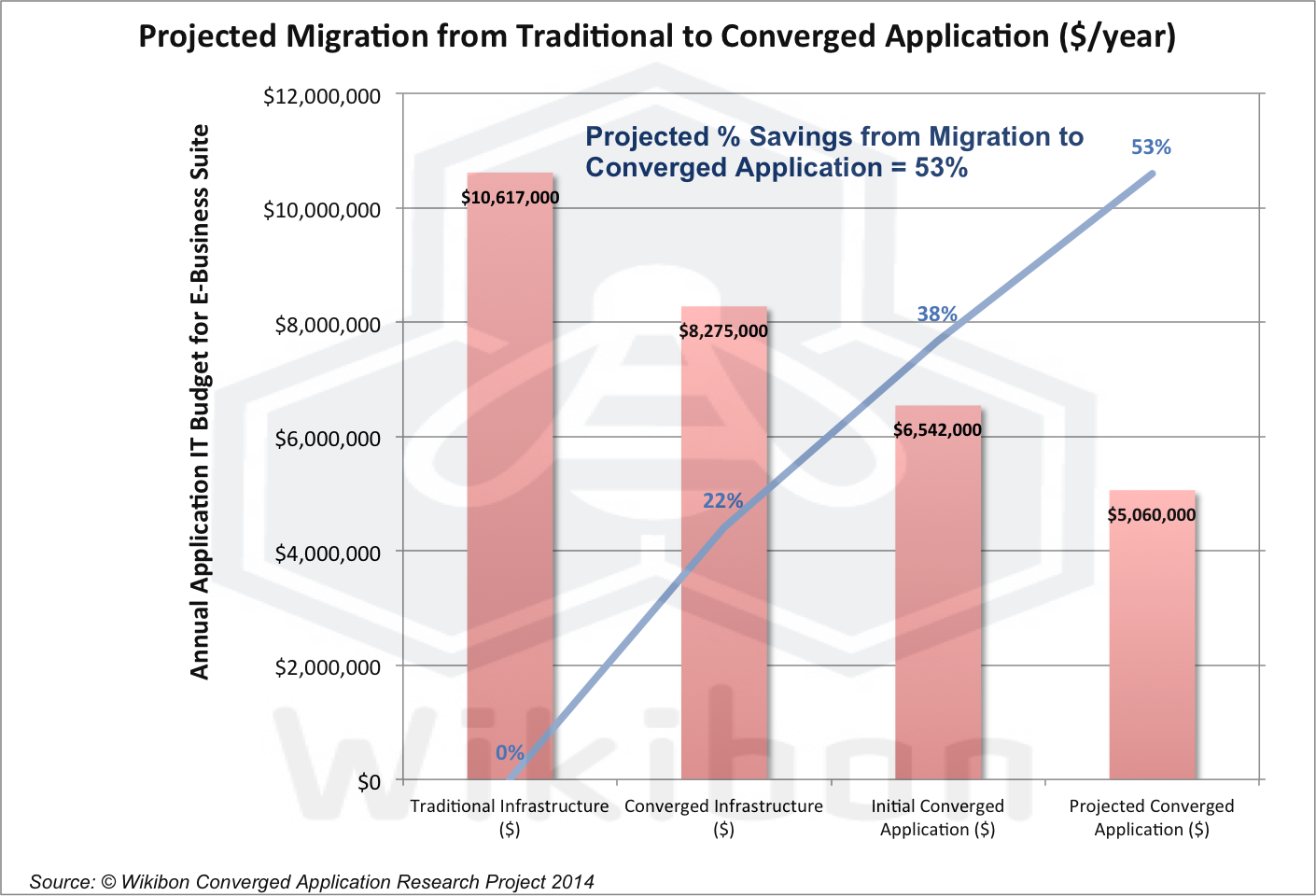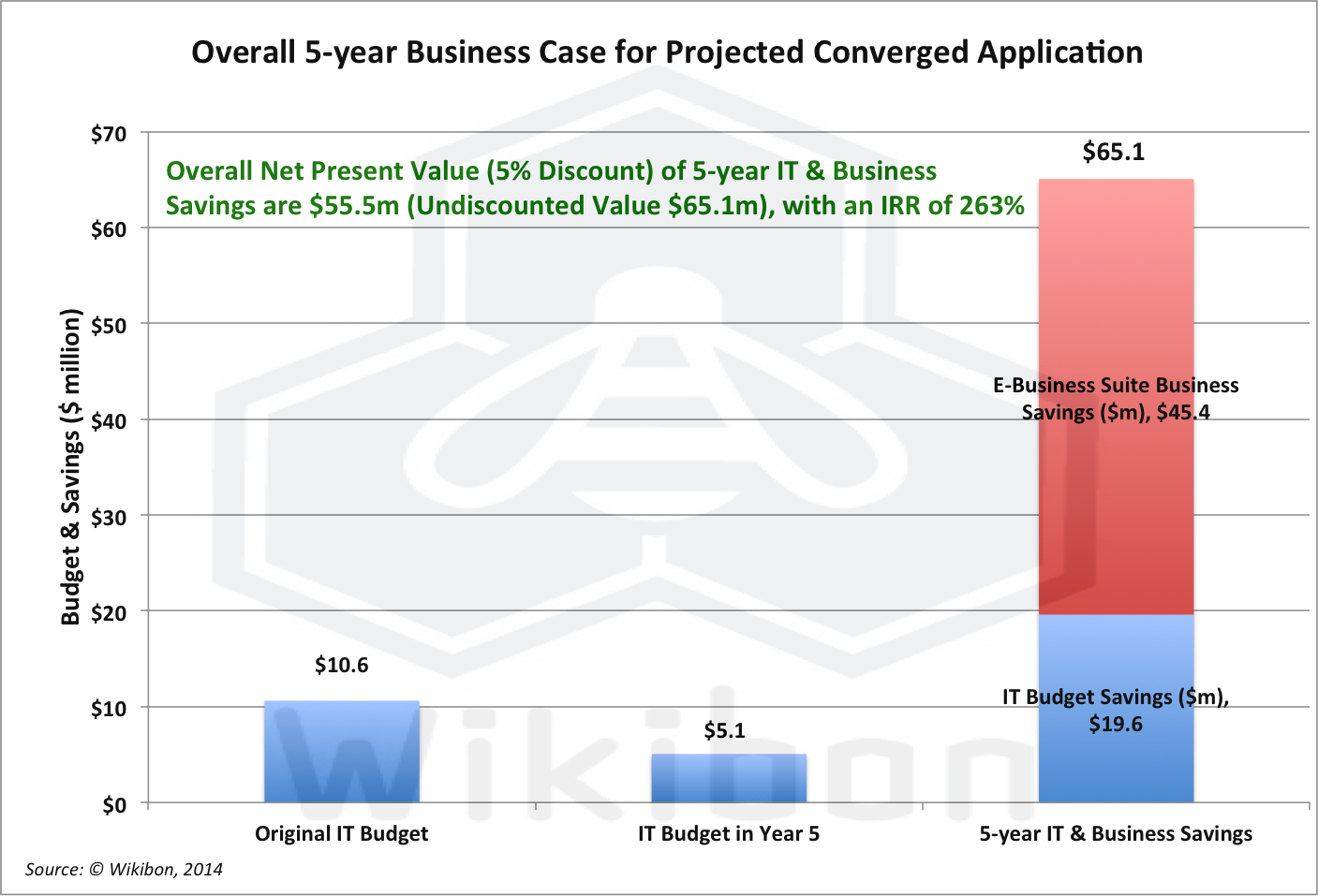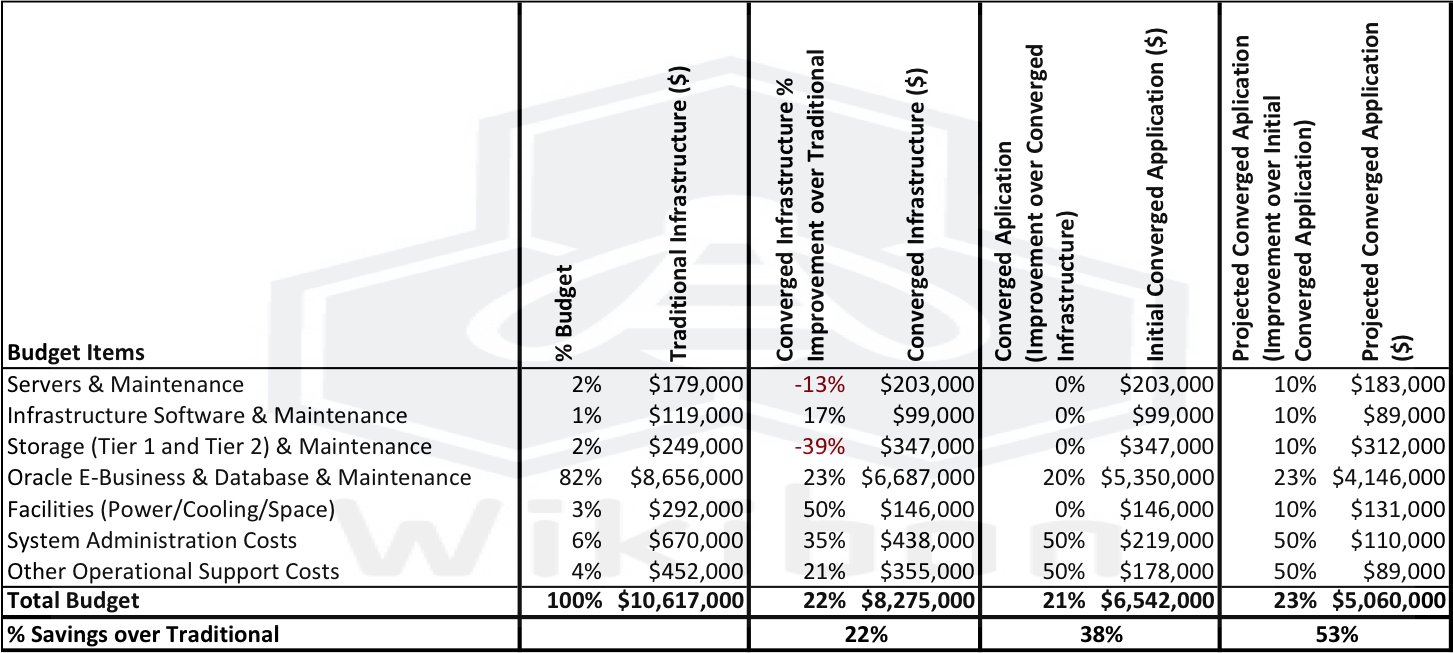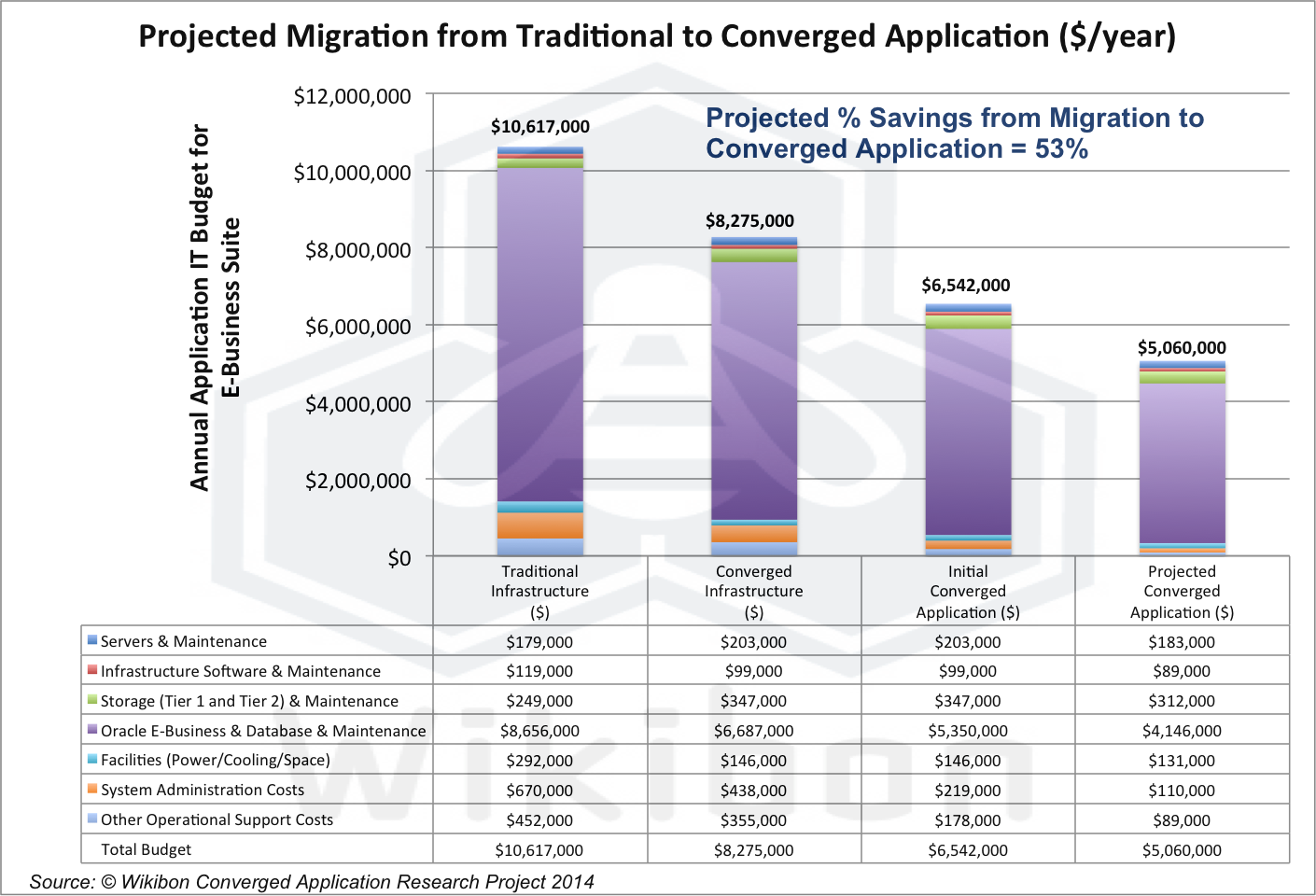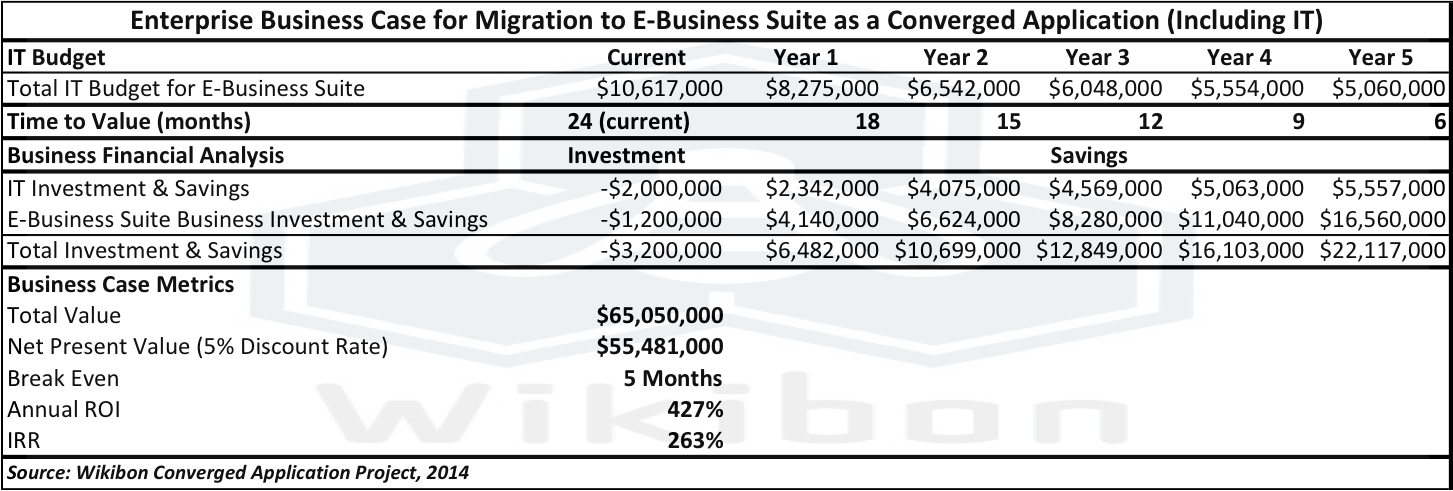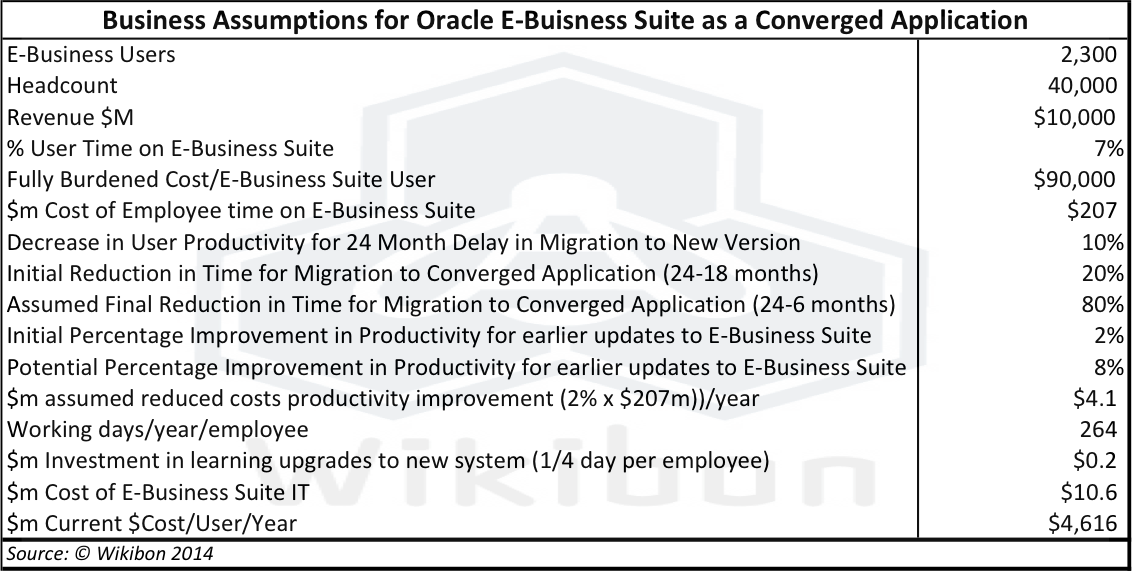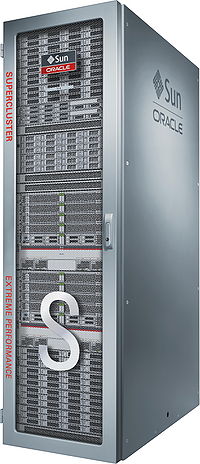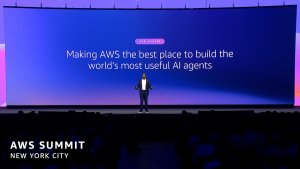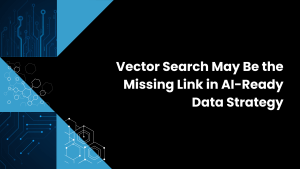Executive Summary
The average age of an enterprise application, according to Oracle President Mark Hurd, is 19 years. Organizations are looking for ways to improve the agility of application development teams on mission critical systems to accelerate time to change/time to value. Our research indicates that “Application Convergence” may be able to address this challenge to a large extent.
Application convergence is a “top-down” view of convergence, led by application development (both ISV and enterprise development). The objective is to dramatically reduce application maintenance costs and radically improve time-to-value from application updates and new functionality. Wikibon has introduced, defined and characterized the concept of a “Converged Applications” model that will eventually allow ISVs and enterprise application developers to deliver change in 2-3 months, compared with historical 18-30 month development cycles for major legacy applications today (Source: Wikibon in-depth interviews).
To illustrate the value, Wikibon has created a financial model for Oracle E-Business Suite installed in an enterprise with 40,000 employees, 2,300 of whom were users of the application. By implementing a “Converged Applications” model, the speed to change can be reduced from 24 months to 6 months over a five year period. Wikibon estimates that the net benefits of such a project would be about $65 million, with a break-even of five months. One third of the benefit would come from reduced IT budgets, and two thirds would come from improved productivity from the E-Business Suite users because of earlier time to improved functionality.
The most important finding of this research is that adopting a converged application model will speed change and reduce cost of delivery of in-house ISV and internally developed applications. A top-down in-house converged applications environment can be competitive with public cloud offerings. Wikibon recommends that ISVs and internal enterprise application development should adopt a converged application strategy, especially for applications with high rates of change. With that change comes the ability to adopt much greater automation of operations from a Dev/Ops or Cloud/Ops environment, which will naturally flow from the implementation of converged applications.
Converged Applications
Today’s ISV- and enterprise-written applications deliver change to their customers in about 2-3 years. There are two elements of change:
- Change 1 Elements:
- Restoring any deprecation in value because existing application ideas & business structures do not fit the evolving business environment as effectively (e.g., new government regulations, new tables) as well as to provide support for new infrastructure hardware and software;
- Change 2 Elements:
- New business and application innovations that increase the value of the application to deliver any combination of increased revenue, decreased cost and/or reduced risk.
Tomorrow’s cloud applications will deliver new value every 2-3 months, an order-of-magnitude improvement over today’s practice. Unless today’s ISV vendors and supporting ecosystem can deliver application change at the same rate as future cloud applications, and at the same time reduce the cost of their own application maintenance to have the resources to focus on change, they will cease to exist within a decade. Unless enterprise application development can make the same adjustment to its applications and application add-ons to ISV applications, the investment in those applications and any protection they give to market share will be history.
The inhibitors to achieving this change are significant, both within the ISVs, their ecosystem partners, and their customers. ISVs have to realign development resources by reducing the effort and elapsed time for application maintenance on Change 1 elements, focusing instead on Change 2 elements. Enterprise application development has to do the same.
Wikibon believes that converged applications are a compelling solution for ISV’s, their ecosystem partners, and their customers. Converged applications are also a solution for enterprise application development. Converged applications can deliver value in a number of ways:
- The percentage of effort and elapsed time for Change 1 elements can be reduced by reducing the degrees of freedom between development and infrastructure;
- New releases can be designed, tested, and delivered on a specific converged infrastructure either by the ISV or its ecosystem partners, with new releases every 2-3 months;
- The most common extensions written by ISV customers can be integrated into the application;
- API interfaces can be developed to allow application extensions to be written with a minimum of testing for new releases;
- Enterprise application development will need to demonstrate to the lines-of-business the true cost of slowing change if applications are modified or if non-standard infrastructure is used, and modern techniques including ISV APIs to monitor and application management can be applied.
Wikibon has put forward a general proposition that reduction in the number of single-managed entities (SMEs) is key to reducing the time to change and the cost of IT. Previous Wikibon research has established this for converged infrastructure. Figure 1 shows the principle of a converged application, encapsulating all the resources into a single service, with a single source, a single source of updates, a single business partner, and a single “throat to choke”.
Wikibon has tested this thesis in previous research up to the database layer. However, if the model in Figure 1 is correct, a “top down approach” from the ISV vendor will bring the greatest benefits to “time to change” and total cost.
Wikibon believes that cloud service providers with applications as a Software-as-a-Service (SaaS) offerings are obtaining significant cost reductions by reducing the number of SMEs. Wikibon observes that the public cloud IaaS providers such as AWS are not standing still and already have Database-as-a-Service and other higher-level services. Wikibon believes that AWS will soon deliver converged applications with offerings such as “Unified Communication” based on Microsoft Exchange, SharePoint & Lync 2013, and will expand to other applications.
Project Scope & Summary Of Findings
It is important for both ISVs and enterprise IT to understand the potential benefits and disadvantages of this approach. In this study, Wikibon wanted to learn whether the general model of reducing cost by reducing the number of SMEs is also applicable to converged applications. This study considers an integrated offering of the Oracle E-Business Suite together with Oracle’s Red Stack SuperCluster as a viable use case. At the moment, Oracle is the only large-scale ISV offering all the elements of the stack.
The objective of this research is to understand the potential benefits of converged applications, including both the application and the middleware supporting the application. It focuses on different models of delivering converged applications, including on-site options. It also focuses on the inhibitors to achieving converged applications and what ISVs and enterprise IT need to do to deliver low-cost converged applications.
Wikibon has previously completed a series of studies demonstrating the economic and business value of single-managed entities (SME), or enhanced converged infrastructure, as a best practice private cloud pathway to achieving public cloud economies.
To support this new research, Wikibon created a model of a traditional annual costs of servicing Oracle E-Business Suite (see Footnotes section “E-Business Suite Modules & Components” for a synopsis of this widespread software). Next, Wikibon mapped out stages on the journey to a fully converged application. The stages are:
- Starting Point – Traditional Enterprise Implementation of E-Business Suite:
- The budget items Wikibon evaluated are shown in Table 1 column one. Column 2 includes the budget item costs. The software budget item is 82% of the cost. It includes the discounted cost of the Oracle database (based functionality included on Server Cores) and E-Business Suite (based on components included, # of users, and other business metrics, and the un-discounted cost of maintenance.
- Using converged infrastructure for running E-Business Suite:
- Wikibon used previous research “Duplicating Public Cloud Economics for Oracle Database Infrastructure” to help evaluate this stage. The cost of E-Business Suite within the software cost budget item remains the same as in the previous stage. The costs of Oracle Database license costs are reduced by using higher performance servers with more DRAM and much faster storage, as described in the previous research.
- Using Today’s Converged Application Environment:
- This section assumes the total number of SMEs is 1.5 (see section “Limitations Of Converged Application Research” below for fuller discussion), using the Oracle SuperCluster as a reference architecture for functionality and support with quarterly updates of database, middleware and application software. We assume that there is not full integration of the quarterly updates,; hence the 1.5 SME evaluation.
- The sources of savings include lower database software costs from virtualization and Oracle software licensing flexibility and lower costs of system and operational staff.
- Future Fully Converged Application Environment:
- The future converged application architecture again assumes the Oracle SuperCluster as the reference architecture and also assumes that at the end of five years the number of SMEs will be one (1). The benefits of a fully converged application environment include better utilization of hardware and infrastructure software, lower database costs, lower E-Business Suite maintenance costs, and virtual elimination of system and operational staff to support applications.
Figure 2 is a summary of the research and shows the resulting reduction in IT costs from migration to converged infrastructure to initial converged application to the projected fully implemented converged application environment. Figure 2 shows a projected reduction in annual IT costs for delivering E-Business Suite components to 2,300 users in enterprise with 40,000 employees and $10 billion in revenue. It shows costs of $10.6 million/year for traditional infrastructure as the base case, reducing 22% to about $8.3 million for converged infrastructure, reducing 38% from base to $6.5 million for initial converged application, and finally reducing 53% from base to $5.1 million for a fully converged application environment.
Source: © Wikibon Converged Migration Research Project, 2014. The detail breakout of the stages is given in Table 1 below.
Click on the image to enlarge.
Figure 3 shows the business case for moving to a fully converged application environment in stages. The saving come from two areas:
- IT savings – the net IT savings are net $19.6 million un-discounted over 5 years:
- The IT investments and savings are shown in the IT Investments & Savings Line of Table 3, in the Business Financial Analysis section;
- More detailed IT saving calculations are provided in the “Assumptions & More Detailed Financial Analysis” section of this posting;
- Business Savings – the business savings are net $40.2 million un-discounted over 5 years:
- The business savings are shown in the Business Financial Analysis section of Table 3;
- More detailed business savings calculations are shown in the “Assumptions & More Detailed Financial Analysis” section of this posting.
Source: © Wikibon Converged Migration Research Project, 2014. The annual 5-year IT expenses, including Organization Change, Procedures & Retraining Costs, are shown in Table 2 below. The business benefits of enhanced value to the users is given in the Business Financial Analysis Section of Table 3.
Click on the image to enlarge.
Figure 3 also shows that the net present value of the converged application project is $51.2 million with a internal rate of return (IRR) of 261% – a “no brainer” rate of return. Table 2 below also shows a break-even of five months and an annual ROI of 394%. Figure 3 shows very clearly that the major overall benefit is a business benefit, the earlier delivery of Change 1 elements shown in the “Converged Applications” section above. The methodology for estimating this (detailed in the next section “Assumptions & More Detailed Financial Analysis”) is very conservative, assuming a 2% decrease in user productivity while using the application every six months. The impact is evaluated using just the cost of employees, and no account is taken of potential value the user creates.
This finding is the reason that Wikibon believes converged application deployment will be led by ISVs and enterprise application development. The primarily reason will be to increase the rate of application change that can be delivered to the market, and to be able to compete with cloud service providers such as ServiceNow that are already pushing out new releases in months.
Assumptions & More Detailed Financial Analysis
Table 1 shows the stages towards a fully integrated converged application model with an SME of one (1). The second column shows the largest percentage of the IT costs for E-Business Suite comes from license costs and maintenance costs (82%). The remaining percentage columns show the percentage reduction in cost for each IT budget line item against the traditional IT base in column 3.
Source: © Wikibon Converged Migration Research Project, 2014.
Click on the image to enlarge.
Table 2 maps the stages in Table 1 onto yearly IT budgets. The Current column is the base traditional IT budget. Year 1 is the Converged Infrastructure column from Table 1. Year 2 is the first stage of the Converged Application model, with an SME of 1.5. Year 5 is the final stage of migration to the Converged Application model, with an SME of 1. Years 3 and 4 are linear interpolations between Year 2 and Year 5.
The yearly budget is the sum of these costs. The “Organization Change, Procedures & Retraining Costs” line item shows the initial investments required to enable each stage. The investments for year 1 and year 2 ($3,2million) are assumed to be taken on day 1 of the project. The investments in the later years are assumed to be taken on day 1 of each year.
Source: © Wikibon Converged Migration Research Project, 2014.
Click on the image to enlarge.
Figure 4 is a detailed version of Figure 2, showing the detailed breakout of IT budgets for each of the stages defined in Table 1.
Source: © Wikibon Converged Migration Research Project, 2014.
Click on the image to enlarge.
Table 3 is the business case for the full converged application model (SME of 1). The first line is the IT budget, taken from the Total IT Budget Item Costs in Table 2. The second line is the assumed number of months for each stage/year of the project. The number of months before a new release can be implemented is assumed to be 30 (2.5 years) currently. This is the time between the release of a new version by the ISV or enterprise application development group, and the time the fully tested version is delivered to the end-users. Migration to converged infrastructure (year 1) is assumed to reduce that to 24 months, and the time to deliver change is reduced by 3 months each year. At the end of the project (year 5) the time to deliver change has been reduced to 12 months. Wikibon believes that this could be further reduced over time down to 3 months. The majority of this effort would have to be led by the ISVs and enterprise application teams for each application.
The business financial analysis section in Table 3 shows the investments and savings for the IT budget and for the improved productivity of the end users. The IT investment ($2 million) and the E-Business Suite investment ($1.2 million) are taken from year 1 and year 2 “Organization Change, Procedures & Retraining Costs” line in Table 2.
The IT savings line for each year is the difference between the IT budgets for each year on the top line.
The assumptions behind the E-Business Suite business savings are given in Table 4. The number of E-Business Suite users is assumed to be 2,300 out of a total workforce of 40,000. The average fully burdened salary of the users is assumed to be $90,000. The cost of the end-users is therefore $207 million/year ($90,000 x 2,300). The cost of delaying implementation of a new version by 24 months is assumed to be 10% of the productivity of the users of E-Business Suite. The reduction of six months by going to converged infrastructure is assumed to improve productivity by 2%. The improvement of 3 months/year for years 2-5 leads to a total improvement at the end of the project is 8%. The initial saving in year 1 is therefore $4.1 million ($207 x 2%). The savings in year 5 are $16.5 million ($207 x 8%).
Source: © Wikibon Converged Migration Research Project, 2014.
Click on the image to enlarge.
Source: © Wikibon Converged Migration Research Project, 2014.
Click on the image to enlarge.
Limitations Of Converged Application Research
As discussed earlier, the application support is not fully integrated. In other words, the application and middleware are not fully, explicitly tested against exactly the same base as the converged database stack. Therefore, Wikibon has assessed the level of integration to be equivalent to about 1.5 SMEs. In addition, the number of accounts with the full configuration was a small subset of all the enterprises interviewed. Therefore, we regard this research as highly suggestive, but not sufficient in itself to corroborate our general thesis concerning SMEs and value.
In addition, Wikibon recognizes that the converged application level of support will not be available for all applications. For large-scale applications of very high core value to an organization, the integrated converged application support model is an excellent and very cost-effective strategy. For smaller scale and more numerous support applications with different databases, a best-of-breed shared fungible infrastructure may offer a more practical approach.
Conclusions & Recommendations
The most important conclusion from this and prior Wikibon research in converged infrastructure is that in-house deployment of applications and infrastructure can be competitive with public cloud implementations, both on price and time-to-value. By providing internal converged applications and providing the major mission-critical core applications an ecosystem of converged infrastructure, enterprise IT and ISVs can be competitive with public cloud offerings. They can take a significant step forward from the current high maintenance model, which dictates an infrastructure support model organized by expertise rather than by application. New application-centric Dev/Ops and Cloud/Ops models will allow ISVs and enterprise IT organization to be more application and business focused and reduce the time for IT to support change from years to months. As enterprises migrate their own data centers to mega-datacenters, and in-house deployment is migrated to collocation within the mega-datacenter, enterprises can adopt a mixed cloud and in-house deployment strategy and avoid throwing away huge IT investments. ISVs can reduce time-to-change and time-to-adoption of additional function from years to months and accelerate the delivery of business value to their clients.
The companies that have embraced the converged application model are mainly the large ISVs that are also systems vendors:
- IBM has developed and sells the PureApplication systems program (the PureFlex initiative is being sold to Lenovo);
- Oracle has developed and sells the SuperCluster (reference architecture for this analysis, see Footnotes below) and the DBA (database appliances) as part of Oracle’s Engineered Systems;
- SAP has developed and sells the HANA appliance;
- VCE (an alliance between CISCO, EMC, and VMware), a smaller ISV, sells VBlock converged systems tdhat can be used by ISVs as building blocks for converged applications.
Action Item: ISVs and enterprise application development should look carefully at the converged application model, and determine the business value of lower IT costs and the line-of-business value of improved speed to deliver change. Wikibon believes that the converged application model will become best practice, especially for applications within verticals and supporting business processes that have significant rates of change. This change will also enable the faster evolution of Dev/Ops and Cloud/Ops as the best practice IT organization.
Footnotes:
Source: © Oracle, downloaded April 11, 2014.
Oracle SuperCluster The Oracle SuperCluster is the most complete engineered system in the Oracle portfolio. The system combines SPARC servers, Oracle Solaris operating system, and Oracle Database running on Oracle Exadata Storage Servers into an engineered system that can be optimized and tuned for consolidating E-Business Suite and other applications (see Figure 5 below).
All components within the Oracle SuperCluster system, including Oracle’s SPARC servers, Oracle ZFS Storage Appliances, and Oracle Exadata Storage Servers, are interconnected over a redundant InfiniBand fabric. Virtualization enables consolidation and helps ensure that applications are isolated from one another. The service instances, application servers, and Oracle Database software are all consolidated on the system.
The maintenance of the SuperCluster can be done with a quarterly release of all the software (Platinum service) excluding the Middleware and Application code. There is an option of configuring an Oracle Exalogic component which includes the Middleware required for E-Business Suite.
E-Business Suite Modules & Components
- Customer Relationship Management
- The main components are Channel Revenue Management, Marketing, Order Management and Service.
- Service Management
- The main components include Inbound Telephony, Outbound Telephony, Scheduler, Depot Repair, Email Center, Field Service, Interaction Center, iSupport, Mobile Field Service, Scripting, Service Contracts, Spares Management, and TeleService.
- Financial Management
- The main components include Asset Lifecycle Management, Cash & Treasury Management, Credit-To-Cash, Financial Control & Reporting, Financial Analytics, Governance Risk & Compliance, Lease and Finance Management, Procure-To-Pay and Travel Expense Management.
- Human Capital Management
- The main components include Global Core Human Capital Management, Workforce Management, Workforce Service Delivery, Talent Management and HR Analytics.
- Project Portfolio Management
- The main components include Project Analytics, Project Billing, Project Contracts, Project Collaboration, Project Costing, Project Management, Project Resource Management and Project Portfolio Analysis.
- Procurement
- The main components include iProcurement, iSupplier Portal, Procurement & Spend Analytics, Spend Classification, Supplier Network, Supplier Hub, Landed Cost Management, Procurement Contracts, Purchasing, Services Procurement, Sourcing, Supplier Lifecycle Management and Oracle Contract Lifecycle Management for Public Sector
- Supply Chain Management
- The main components include Advanced Procurement, Value Chain Execution, Order Orchestration/Fulfillment, Asset Lifecycle Management, Manufacturing, Product Value Chain Management, Value Chain Planning and Business Intelligence/Analytics
- Value Chain Planning – includes integration with JD Edwards EnterpriseOne
- The main components include, Planning Command Center, Supply Chain Planning, Collaborative Planning, Demand Management, Demand Signal Repository, Global Order Promising, Inventory Optimization, Predictive Trade Planning/Optimization, Production Scheduling, Rapid Planning, Real-Time Sales/Operations Planning, Service Parts Planning and Strategic Network Optimization
- Value Chain Execution
- The main components include Transportation Management, Landed Cost Management, Warehouse Management, Global Trade Management, Mobile Supply Chain and Inventory Management

